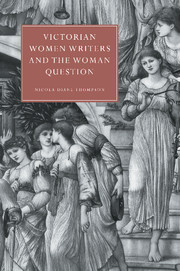Book contents
- Frontmatter
- Contents
- List of illustrations
- Notes on contributors
- 1 Responding to the woman questions: rereading noncanonical Victorian women novelists
- 2 Marriage and the antifeminist woman novelist
- 3 Breaking apart: the early Victorian divorce novel
- 4 Phantasies of matriarchy in Victorian children's literature
- 5 Gendered observations: Harriet Martineau and the woman question
- 6 Maximizing Oliphant: begging the question and the politics of satire
- 7 Literary women of the 1850s and Charlotte Mary Yonge's
- 8 Portraits of the artist as a young woman: representations of the female artist in the New Woman fiction of the 1890s
- 9 Lady in green with novel: the gendered economics of the visual arts and mid-Victorian women's writing
- 10 Ouida and the other New Woman
- 11 Organizing women: New Woman writers, New Woman readers, and suffrage feminism
- 12 Shot out of the canon: Mary Ward and the claims of conflicting feminism
- 13 E. Nesbit and the woman question
- 14 “An ‘old-fashioned’ young woman”: Marie Corelli and the New Woman
- CAMBRIDGE STUDIES IN NINETEENTH-CENTURY LITERATURE AND CULTURE
13 - E. Nesbit and the woman question
Published online by Cambridge University Press: 01 March 2010
- Frontmatter
- Contents
- List of illustrations
- Notes on contributors
- 1 Responding to the woman questions: rereading noncanonical Victorian women novelists
- 2 Marriage and the antifeminist woman novelist
- 3 Breaking apart: the early Victorian divorce novel
- 4 Phantasies of matriarchy in Victorian children's literature
- 5 Gendered observations: Harriet Martineau and the woman question
- 6 Maximizing Oliphant: begging the question and the politics of satire
- 7 Literary women of the 1850s and Charlotte Mary Yonge's
- 8 Portraits of the artist as a young woman: representations of the female artist in the New Woman fiction of the 1890s
- 9 Lady in green with novel: the gendered economics of the visual arts and mid-Victorian women's writing
- 10 Ouida and the other New Woman
- 11 Organizing women: New Woman writers, New Woman readers, and suffrage feminism
- 12 Shot out of the canon: Mary Ward and the claims of conflicting feminism
- 13 E. Nesbit and the woman question
- 14 “An ‘old-fashioned’ young woman”: Marie Corelli and the New Woman
- CAMBRIDGE STUDIES IN NINETEENTH-CENTURY LITERATURE AND CULTURE
Summary
In E. Nesbit's fantasy, The Magic City(1910), two children, Philip and Lucy, travel to a realm governed by an edict decreeing that “Girls are expected to be brave and the boys, kind.” The children are followed by Philip's nursemaid, who becomes the “Pretenderette” to the city-kingdom's throne. In this character (her title is derisively similar to “suffragette”), Nesbit satirizes both working-class resentment and the New Woman's political ambition. After the children defeat the Pretenderette, her crimes are symbolically chastised by enforced “proper” female activity – learning to feel affection for others (nurturing) and reforming the allegorical dragon Sloth (the maintaining of moral standards). Although Lucy has successfully insisted that Philip obey the ruling precept and accept her agency on several occasions, her selfenforced emancipation is countered by the Pretenderette's fate, a strategy typical of Nesbit's ambivalence toward, if not compromise with, her contrary impulses toward sustaining and undermining the hegemony of conventional female roles.
Nesbit, born in 1858, did not begin her career as a novelist until she was nearly forty; thus her first novel, The Secret of Kyriels (1899), was written at the end of the period normally assigned to the New Woman novels; Nesbit is clearly a late entry into the field, but perhaps the currently stylish term “retro” best describes her adult fiction. An innovator in defining the children's time fantasy – although F. Anstey's The Brass Bottle (1900) preceded her stories, her work has influenced writers from C. S. Lewis to Edward Eager – her fiction for adults resembles what had been available to her in her twenties and thirties and is recognizably a holdover from the heyday of the New Woman novels.
- Type
- Chapter
- Information
- Victorian Women Writers and the Woman Question , pp. 223 - 240Publisher: Cambridge University PressPrint publication year: 1999
- 4
- Cited by



